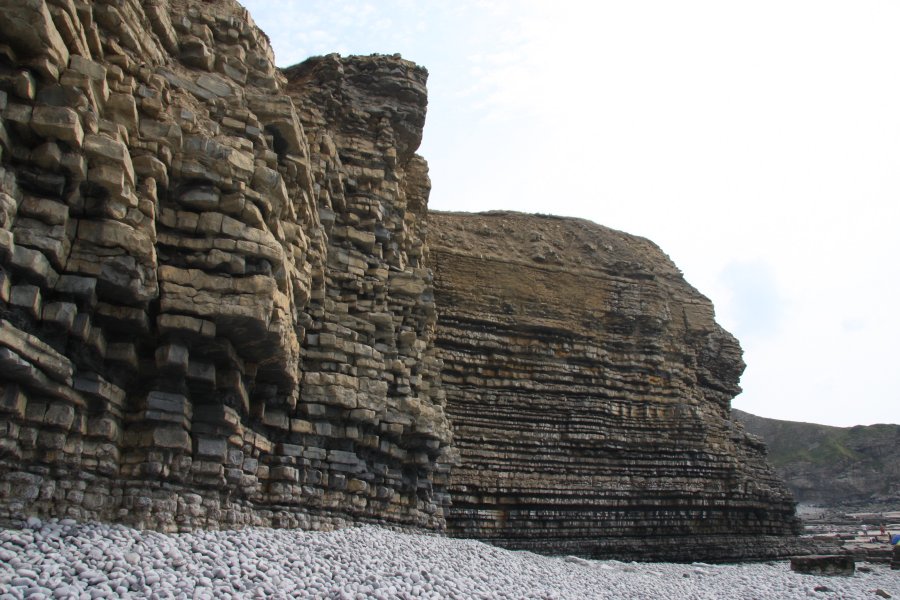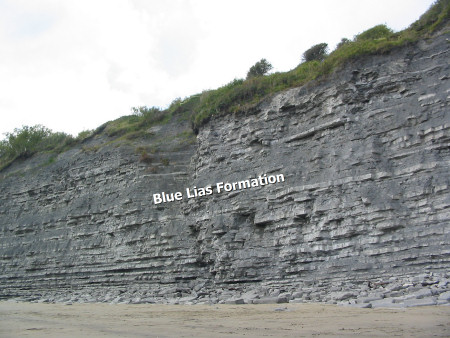Blue Lias
The Blue Lias Formation is a sedimentary formation that occurs in the south, west and east of England and southern Wales, Northern Ireland and the west of Scotland. It was deposited in the Triassic to Lower Jurassic period Supreme.
Etymology
The name Blue Lias is derived from the English. blue (blue) in allusion to the blue-gray tint of the rock - in contrast to the subjacent White Lias, who is white. Lias is an old dialect word of the quarry workers of layers ( plies ) and refers to the characteristic plant construction.
History
Already in 1811, Mary & Joseph Anning had discovered in the Blue Lias Formation at Lyme Regis the first Ichthyosaurus. A first detailed description of the formation in 1826 by Henry Thomas de la Bèche. Thomas Wright created in 1886 stratigraphy of the formation into which he incorporated his pioneering work on the Lias ammonites. A standard work on the Geological Survey Memoir of 1911 by HB Woodward & W.A.E. Usher. 1923 WD Lang began his mikrostratigraphisches monumental work, in which he described the whole formation, centimeter by centimeter.
Geography
The Blue Lias Formation, often referred to simply as Blue Lias, in the following sedimentary basins occurs in the United Kingdom:
- In the Wessex Basin on the south coast. Beautiful outcrops are located on the Jurassic Coast in Dorset, especially on the cliffs of Charmouth and Lyme Regis. Upcoming is the Blue Lias Formation in the north of the Wessex Basin in Somerset, particularly around Glastonbury and the Polden Hills.
- In the Bristol Channel Basin in southwest England. Open-minded is the formation on the coast of South Wales and the Vale of Glamorgan. The type locality of the Blue Lias Formation is located at Saltford near Bath.
- In Cardigan Basin on the west coast of Wales.
- In the Celtic Sea Basin in the southwest of Britain.
- In the Cleveland Basin in North West England. In the East Midlands the Blue Lias Formation forms a vast plain.
- In the Hebrides Basin on the north coast of Ireland ( Antrim ) and on the north west coast of Scotland ( Skye ).
Stratigraphy
The generally flat-lying Blue Lias Formation, the lowest formation of the Lias Group, overlaid by a layer gap concordant the Langport member of the Lilstock formation of the Penarth Group. You can put down as well as access to the underlying Cotham Members. The Blue Lias Formation is in turn overlaid conformably by the Charmouth Mudstone - formation. Three members can be excreted within de Formation ( from young to old):
- Rugby Limestone Member
- Saltford Shale Member
- Wilmcote Limestone - Members
Lithologically there is the 30 to 40 meters thick expectant Blue Lias Formation of a rhythmic alternation of limestones, marls, siltstones and rare dark mudstones in the decimeter range. The partly laminated, nodular or massive and aushaltenden Kalklagen can reach a thickness 10 to 30 centimeters. A relationship of these alternations to Milankovitch cycles is suspected. However, it is not clear which of these cycles ultimately for the Blue Lias formation is decisive ( precession with 26000 or inclination of the Earth with 41000 years ).
An idealized, between 20 and 100 centimeters powerful expectant change cycle is structured as follows ( from Hangendem to footwall ):
- Final Kalklage
- Marl layer
- Bituminous Tonsteinlage
- Basal marl layer
The basal marl layer transgrediert over the pierced at the surface of Wurmbauten and other sediment dwellers and ransacked Kalklage of the previous cycle. It may contain bivalves and ammonites. Over it reaches the concordant bituminous, finely layered Tonsteinlage that can contain to 10% organic matter and 5% calcium carbonate. Your base is flat, its surface irregular but since crossed by buildings. This very probably in deeper water isolated position leads pyrite and is generally very poor in fossils, but may show occasional ammonites, fish scales and small bivalves. It is believed that on the seabed ruled anaerobic conditions, and that the organic content is due to explosively dinoflagellates proliferating in the photic area. The subsequent marl layer of 65 % clay and 35 % calcite is also heavily infiltrated at its top with Wurmbauten. Inside the shell layer, couples find of bivalves and sometimes studded with oysters tree trunk remains. In the final Kalklage is a Kalzilutit, which consists of 80% CaCO3 and 20 % clay. It is quite rich in fossils ( bivalves, gastropods, brachiopods, echinoderms and swallowed expressed ammonites) and its top reaching to Wurmbauten of taxa Chondrites, Thalassinoides and Diplocraterion. The Kalklage was probably deposited under regressive conditions.
The Blue Lias Formation is composed of about 50 of these alternations. After the lagoonal Penarth Group of Rhäts it is in the Mesozoic, the first clearly marine formation in the UK. The water depth and thus the marine character of the formation to take the hanging wall to back and the marine fauna is diversified.
Fossil content
The Blue Lias Formation extends over five ammonite zones ( from young to old):
- Arnioceras semicostatum
- Arietites buck landi - Sinemurian
- Schlotheimia angulata - Hettangian
- Alsatites liasicus
- Psiloceras planorbis
Among them is still the Präplanorbienzone, which represents the beginning of Hettangiums.
In addition to the zone ammonites there are still other taxa such as Agassiceras ', Arnioceras obliquicostatum, Arnioceras pseudokriodon, Caloceras intermedium, Charmasseiceras, Euagassiceras, Paracoroniceras lyra, Psiloceras plicatulum, further Nautiloidea as Cenoceras striatum and Nautilus and belemnites.
At invertebrates contains the Blue Lias Formation bivalves ( Gryphaea, Inoceramus, Liogryphaea, Liostrea, Ostrea, Oxytoma inequivalvis, Pecten, Plagiostoma, Uniocardium and Volsella minima), brachiopods ( Calcirhynchia and Spiriferina ), crinoids ( Pentacrinites ) and Echinodermenstacheln.
Numerous Vertebratenfunde were made in the Blue Lias Formation:
- Fish, mainly Teleostomi ( Actinopterygii ). Most fish finds come from the Fish and Fish Bed Bed Shales in the uppermost portion of the Blue Lias Formation, including the taxa: Belonorhynchus
- Caturus
- Chondrosteus
- Dapedium
- Eugnathus
- Heterolepidotus
- Osteorachis
- Pholidophorus
- Ptycholepis
Worth mentioning the haiähnliche cartilaginous fish Hybodus.
- Dinosaurs, including the Ceratosauria ( indefinite residues from Warwickshire ), including Sarcosaurus woodi ( Leicestershire ) and Sarcosaurus andrewsi ( shin from Warwickshire )
- Scelidosaurus harrisonii ( two fairly complete findings from Dorset)
- Eurypterygius communis, Eurypterygius intermedius and Ichthyosaurus platyodon
- Rhomaleosaurus cromptoni
- Dimorphodon macronyx ( Lyme Regis)
The Blue Lias formation leads next to the tree trunks already mentioned also plant remains, including the Cycadales Cycadeoidea gracilis, Cycadeoidea pygmaea, Cycadites, Otozamites and Pagiophyllum and ferns Ctenopteris and Thinfeldia. The lignithaltigen logs indicate the presence of other conifers such as Araucaria or cypress.
Age
Absolute age determination for the Blue Lias Formation are not known. Biostratigraphically the Hettangian starts about 4 feet above the basal, brown, lignithaltigen Tonsteinlage ( layer H1). Thus, the formation is still a top- Rhaetian. The uppermost layer ( layer 53 ) completed the Arnioceras semicostatum Ammonites zone of Sinemuriums. The Blue Lias Formation thus spans approximately the period 200 bis 194 million years BP.









